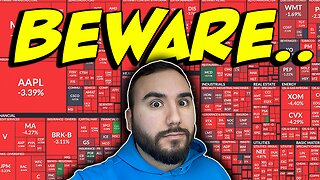Stock Market Valuation Series Part 5: S&P 500 Mean Reversion Model
My Exclusive Free Workshop The Four P's of Building a Successful Investing Program → https://spxinvesting.mailchimpsites.com
Blog: https://spxinvestingblog.com
https://www.facebook.com/groups/433843641082343
https://www.multpl.com/sitemap
https://www.currentmarketvaluation.com/
Videos Referenced:
Stock Market Valuation Video Series Part 1 Miltpl.com: https://youtu.be/y0BxSkpJotA
Stock Market Valuation Video Series Part 2 The Shiller PE Ratio: https://youtu.be/3VNCA89kWDo
Stock Market Valuation Series Video Part 3 The Yield Curve Model: https://youtu.be/5Vo9OfMuAss
Stock Market Valuation Series Video Part 4 Buffett Indicator Model: https://youtu.be/5Vo9OfMuAss
Is the Stock Market Getting Ready to Crash? https://youtu.be/F4VUuOBy4mc
S&P 500 P/E Ratio Valuation Update August 1, 2021: https://youtu.be/9f3JSj0EpUY
Mutual Funds: https://youtu.be/hRip-z93PI0
ETFs: https://youtu.be/N_Dk1yn-mxs
Moving Averages and Oscillators: https://youtu.be/ge0KiCIjpzE
Stock Market Valuation Series
Part 5
Tools can be used to determine if the stock market is:
Overvalued: Expensive
Undervalued: Cheap
Fairly Valued: Just about right
Mean Reversion
Mean reversion studies how far current prices have deviated above or below the average prices.
Deviations can last months, years or even decades.
Mean reversion is best used for long-term big picture analysis.
The S&P500 is currently 89%, or almost 2.5 standard deviations, above its historical mean.
This suggests the SPX is Strongly Overvalued.
Conclusion
The S&P 500 Mean Reversion Model posted by the Current Market Valuation website is Strongly Overvalued.
Other Stock Market Valuation measurements show that the S&P 500 is OVERVALUED.
No immediate action is necessarily warranted.
However, it is necessary to have a plan developed and in place in case the market environment changes.
If other measurement tools suggest a major change in trend (up to down) implementing a plan will be in order for:
Those who have only long positions (defensive).
Those who participate in short positions (offensive).
-
 21:37
21:37
The SPX Investing Program
2 years ago $0.09 earnedMarket Valuation Series Part 1: Multpl.com
194 -
 18:27
18:27
The SPX Investing Program
2 years ago $0.20 earnedMarket Valuation Series Part 2: Shiller PE Ratio
245 -
 13:16
13:16
Stas Talks Stocks
1 year agoS&P 500 ANALYSIS: 7 STOCKS TO BUY NOW🚀
1 -
 0:36
0:36
cfl41137
7 months agoStock Market Simplified: Trends, Picks & Analysis
3 -
 9:09
9:09
Stas Talks Stocks
1 year agoS&P 500 ANALYSIS: STOCK MARKET ABOUT TO COLLAPSE⛔️
2 -
 5:22
5:22
LumleyTrading
1 year ago$MU Stock Analysis - Micron Price Targets & Technical Analysis
8 -
 35:07
35:07
The SPX Investing Program
2 years agoS&P 500 P/E Ratio Valuation Update August 1, 2021
226 -
 10:16
10:16
LumleyTrading
1 year agoMGM RESORTS Analysis - $MGM STOCK PRICE PREDICTION & TARGETS
11 -
 15:02
15:02
BitcoinAdvizers
7 months agoIs Now the Time to Buy or Brace for a Reversal? Daily Technical Analysis and Price Targets!
16 -
 48:59
48:59
The Crypto Sniper
8 months agoUnveiling the 20K Reversal: Bitcoin's yearning for a TOTAL MC H&S dump
231